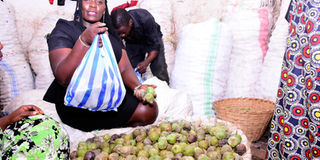Pick more from passion fruits

Farmer sells her passion fruits in the market. On average she earns about Shs600,000 per bag. PHOTO | RACHEL MABALA
Passion fruit, a climbing vine, is a versatile crop whose demand is growing in both export and domestic markets.
The fruit can be eaten fresh or consumed after extracting the pulp and making juice.
The juice is used in a variety of products and the pulp may be added to different dishes. A wide range of cosmetic products and food flavours are derived from the fruit that is rich in Vitamins A and C and carotene.
Varieties
Yellow and purple types exist. Purple varieties do better at higher altitudes than the yellow types. Yellow types, on the other hand, tend to yield higher and are more resistant to diseases.
The purple variety is acidic, varies in taste and juiciness with intense aromatic scent and round in shape. The yellow variety is bigger, with similar taste but possibly less aromatic, more acidic and is also round in shape.
“Both varieties are green before ripening, and they are grown for commercial and domestic purposes,” says Julius Ahagaana a passion fruit agronomist.
Requirements
Excess rainfall causes poor fruit set and encourages diseases mainly leaf and fruit rusts. For good production, passion fruits do well in a variety of soils, which should be reasonably deep and fertile with soil pH ranging between 6.0 and 6.5.
In high rainfall areas, the soils should be well-drained as plants will not withstand waterlogging or flooding.
Planting
Passion fruit can be grown from seeds but grafting often produces improved stock.
Yellow passion fruit is best for production of rootstock because of superior disease resistance while purple is good for fruit production. Seeds germinate in four weeks after removal of the pulp and drying. Production of seedlings in plastic bags is the most used method.
Up to three seeds are planted in each bag and then thinned to one after emergence.
Seedlings will require up to four months to reach a suitable transplanting growth stage. After about seven weeks of growth following transplanting, each plant should have up to four healthy lateral stems.
Transplanting should be done at the beginning of the rainy season. Passion fruit has deep roots, so soils should be well-tilled. Transplant to a field with posts having wire trellis to support the growing crop and fruits produced.
The vines are usually directed so that growth is in both directions along the supporting wires. Yields are highest following a regular fertilisation regime. Old or dead shoots should be pruned.
Passion vines are planted 2m from one row to the other and 3m from one plant to the other. Horizontal trellises have cross-pieces at the top of each post with two to four wires strung horizontally 60cm apart along the top of each cross-piece.
Vertical trellises consist of heavy posts without cross-pieces, with two to three wires strung along the row like barbed wire fencing, attached to the posts from the top down at intervals of about 30-40cm apart.
Trellis wires should be size 9 or 10 galvanised steel. The posts need to be stout enough to withstand the weight of the vines and fruits produced throughout a season that normally includes the buffeting of strong winds. Ideally, they should be long enough to provide a trellis height of 1.5m, with 45-75cm in the ground.
Fertiliser
At planting, use 175g of Triple Super Phosphate (TSP) and one ‘debe’ (about 20 kilogrammes) of farmyard manure and mix well. To obtain high yields, regular fertilisation is necessary.
Apply 300g of Calcium Ammonium Nitrate (CAN) per plant per year in two applications of 150g each during rainy season. Spraying with foliar feeds and trace elements is also recommended.
Crop protection
Weeding is essential when the plants are first transplanted. Disease is usually sufficiently controlled by crop rotation as plantations are not kept for more than three years.
Infected plant material should be pruned and destroyed and vines kept as open as possible to allow thorough application of sprays. Diseases can also be controlled by combination of good management, good orchard hygiene, and a suitable spray programme.
Pests lower fruit quality and should be controlled by regularly checking the areas around the orchard for signs of build-up. If necessary, spray to control the pests.
Harvest
When ready for harvesting, the skin of the fruit is deep purple or yellow. Its pulpy interior is bright yellow, filled with small black seeds. For fresh market or use, the fruit is picked when colour changes occur.
For processing, the fruit is allowed to drop to the ground and picked at least every second day. At this stage, the fruit is shrivelled but quite suitable for processing. Yields decline each year until harvests are not adequate in the four year.




